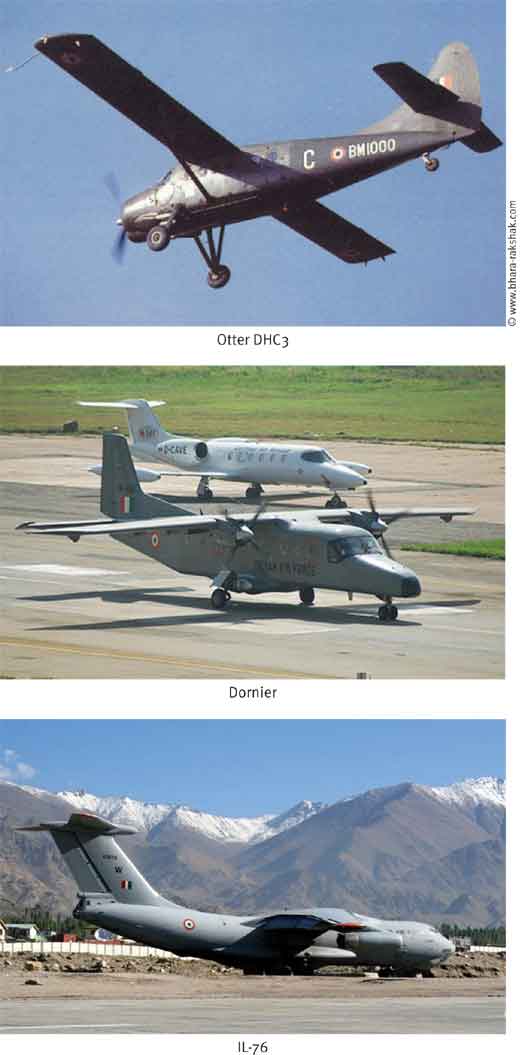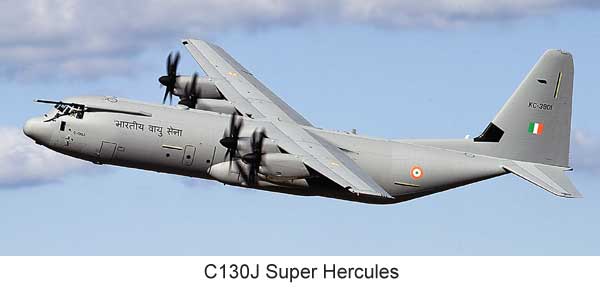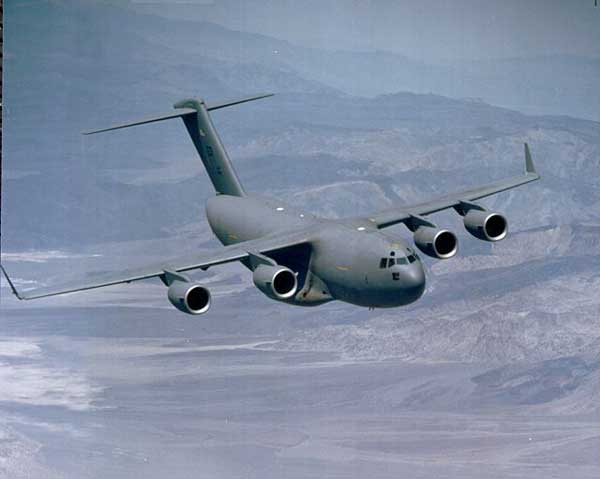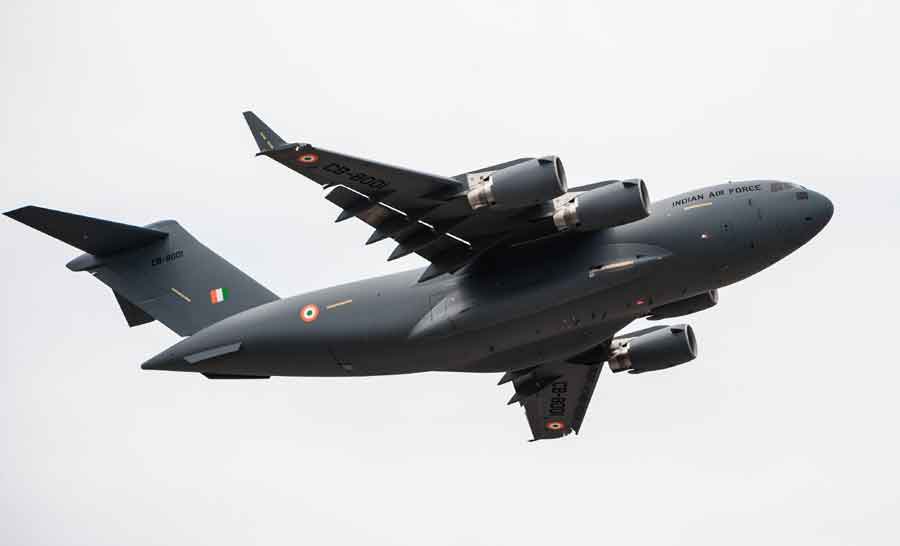With profound changes in the geo-political environment following the demise of the Cold War and the emergence of a new world order, fresh equations with the western world have emerged, most notably by way of a strategic partnership with the US. Dependence on foreign sources has also been aggravated by the total lack of indigenous capability to manufacture military transport aircraft, rhetoric to the contrary in this regard from the aerospace industry and the leadership notwithstanding. Consequently, the IAF now has options and opportunities for induction of the latest technologies hitherto not accessible. And the IAF seems to be making good use of the opportunity to upgrade its transport fleet and thereby enhance its operational capability.
Early Days
The first lot of aircraft to populate the relatively less glamorous transport fleet of the Indian Air Force after the Partition was the Douglas DC3 and its derivative, the C47 which was the ubiquitous Dakota, affectionately referred to as the “Gooney Bird”. The primary peacetime role of the transport fleet was air maintenance of troops deployed in forward locations. However, the role played by the fleet of Dakotas in saving the Kashmir valley is well documented and needs no iteration. The fleet was augmented in the period 1954 to 1963 by the twin-piston-engine Fairchild Packet C119G.These were acquired second hand from the US – some purchased at low cost and few came gratis. Later, a jet engine was installed on top of the fuselage to run on the 130/145 High Octane Avgas on which the two piston engines operated. This unique modification by Indian engineers significantly enhanced performance of the machine and its operating safety margins.
The renowned American King of Comedy, Bob Hope is reported to have travelled to Korea during the war there to entertain US troops. When queried by the media on landing in Korea as to what the figure 119 in the name of the aircraft he travelled on signified, in his characteristic and inimitable style he muttered, “Must be the year of manufacture!” Despite Bob Hope’s snide remark, the C119 in its time was a modern aeroplane capable of operating effectively in hot and high conditions from semi-prepared surfaces with handsome payload. Typical of American design, the ergonomics of the cockpit were excellent. The aircraft was designed and built for supreme crew comfort and efficiency. However, this was not the case with the passengers who were exposed to extremely high levels of vibration and noise especially on take-off.
 Operationally, the C119G was well suited for airborne assault operations and aerial delivery of paratroops, heavy equipment such as medium artillery and light vehicles such as the Willy Jeep directly into the battlefield. These capabilities were effectively demonstrated in the airborne assault operations in Bangladesh in December 1971. Despite lack of pressurisation, the aircraft set a number of records in high altitude operations landing on a regular basis on semi-prepared airstrips in Ladakh at Thoise (9,800 feet Above Mean Sea Level or AMSL), Fukche (13,800 feet AMSL), Daulat Beg Oldi (16,000 feet AMSL) and at Leh (11,500 feet AMSL). In the period March 1961 to July 1963, the four engine turboprop AN12 of ten-tonne payload capacity and the much smaller twin piston-engine IL14 were procured from the Soviet Union. The IL14 and the AN12 fleets were retired from service in the early nineties.
Operationally, the C119G was well suited for airborne assault operations and aerial delivery of paratroops, heavy equipment such as medium artillery and light vehicles such as the Willy Jeep directly into the battlefield. These capabilities were effectively demonstrated in the airborne assault operations in Bangladesh in December 1971. Despite lack of pressurisation, the aircraft set a number of records in high altitude operations landing on a regular basis on semi-prepared airstrips in Ladakh at Thoise (9,800 feet Above Mean Sea Level or AMSL), Fukche (13,800 feet AMSL), Daulat Beg Oldi (16,000 feet AMSL) and at Leh (11,500 feet AMSL). In the period March 1961 to July 1963, the four engine turboprop AN12 of ten-tonne payload capacity and the much smaller twin piston-engine IL14 were procured from the Soviet Union. The IL14 and the AN12 fleets were retired from service in the early nineties.
Modernisation in the Eighties
After over three decades of yeoman service, the fleet of C119G was retired from the IAF in the early eighties to be replaced by over 100 of the Antonov AN32 acquired from the Soviet Union. Since then, along with the AN12 and the 43-tonne payload capacity IL76, also acquired in the mid-eighties, constituted the mainstay of the transport fleet of the IAF. These two aircraft played a crucial role in induction and support of the Indian Peace Keeping Force in Sri Lanka in the period July 1987 to March 1990. Also in 1988, two IL76 aircraft of the IAF along with para commandos of the Indian Army undertook an emergency mission to the Maldives in response to an appeal by the government there for military intervention. The island nation was confronted with a serious threat by way of invasion by mercenaries sponsored by forces inimical to the government of the Maldives. Timely intervention by the expeditionary force foiled the attempt by the invading forces to overthrow the government of the island republic.
A Challenge before the Private Sector
Apart from the fleet of medium tactical airlift AN32 aircraft and the strategic airlifter-the IL76, the IAF also possessed few smaller transport aircraft such as the piston engine De Havilland Caribou DHC4 and Otter DHC3, both of Canadian make, the turboprop Hawker Siddeley HS748 Avro from the UK and the Dornier 228 from Germany, both produced under licence by Hindustan Aeronautics Limited (HAL). Of these, the Caribou and the Otter were retired several years ago. The DO228 continues in service in the training and light transport role and the IAF is currently evaluating options for the replacement of the 40- odd that remain in service with the fleet nearing the end of its technical life having undergone mid-life upgrade a few years ago.
As publicly stated by Air Chief Marshal NAK Browne, Chief of the Air Staff that the IAF would expect the indigenous aerospace industry in the private sector to develop and produce a suitable replacement for the Avro fleet – certainly a creative move by the IAF that would provide the much needed impetus to the private sector. However, it remains to be seen as to whether the indigenous aerospace industry in the private sector is able to rise to the occasion and receives the level of support it would need from the government in this effort. Given the fact that currently, the aerospace industry in the private sector is engaged primarily on low end outsourced work from HAL and global aerospace majors focussed mainly on machining of components, to expect the private sector to produce a military aircraft on their own from scratch may be imprudent and something of a tall order.
The more viable and practical option would be to identify aircraft in this category in the global market already proven operationally and explore the possibility of collaboration with the concerned Original Equipment Manufacturer (OEM). While it is encouraging that the IAF is at least beginning to think along these lines, it would need to be proactive to drive the project and not remain a mute spectator as has been the case with the other indigenous aircraft development projects with HAL so far. The price of indifference will be unaffordable.
Post-Cold War Scenario
The pronounced tilt towards the Soviet Union in the regime of military hardware was essentially a fallout of the Cold War. In those days, Soviet military aircraft were rugged, lacked technological sophistication when compared with equipment of similar vintage of western origin and came at a much lower acquisition cost on extremely favourable financial terms. Given the option, the IAF would have preferred western technology but the primary impediment to this aspiration was political.
Driven by a resurgent economy, India has been on a growth trajectory for the last decade and a half and is now set on a path to emerge as a regional power that would confer upon the nation a new role and enhanced responsibilities for maintaining peace and stability not only in the immediate neighbourhood but also in the region. On account of compulsions of energy security and broad economic interests, India will need the capability for projection of power and speedy response to contingencies to safeguard her interests that would now extend from the Middle East and the Central Asian Republics to South East Asia.
With profound changes in the geo-political environment following the demise of the Cold War and the emergence of a new world order, fresh equations with the western world have emerged, most notably by way of a strategic partnership with the US. Dependence on foreign sources has also been aggravated by the total lack of indigenous capability to manufacture military transport aircraft, rhetoric to the contrary in this regard from the aerospace industry and the leadership notwithstanding. Consequently, the IAF now has options and opportunities for induction of the latest technologies hitherto not accessible. And the IAF seems to be making good use of the opportunity to upgrade its transport fleet and thereby enhance its operational capability.
New Acquisitions from the US
The first to be inducted were the three Boeing Business Jets (BBJ) for Air Headquarters Communication Squadron dedicated to VVIP travel. Acquired through the Foreign Military Sales (FMS) programme of the US government and not through the open tender system, the BBJs replace the three ageing Boeing 737 aircraft acquired earlier on from the Indian civil aviation sector. The BBJs augment the four Embraer 135 Legacy Business Jets from the Brazilian manufacturer already in service with the Squadron.
 The next big ticket purchase has been the six four-engine turboprop C130J Super Hercules aircraft for Special Operations procured from US aerospace major Lockheed Martin through the FMS route in a deal worth $1 billion (` 5,000 crore). The relatively small fleet is already operational with the IAF having taken part in disaster relief operations in Sikkim after the recent devastating earthquake. It is understood that six additional C130J aircraft are to be ordered soon to bring the fleet to full squadron strength. With a maximum payload capacity of over 21 tonnes, the Super Hercules bridges the gap between the five-tonne payload capacity AN32 and the 43-tonne capacity IL76. Apart from its capability to carry 128 fully equipped soldiers or 92 paratroops, the aircraft is capable of both strategic and tactical roles. It has good hot and high performance and can operate from semi-prepared and short dirt strips.
The next big ticket purchase has been the six four-engine turboprop C130J Super Hercules aircraft for Special Operations procured from US aerospace major Lockheed Martin through the FMS route in a deal worth $1 billion (` 5,000 crore). The relatively small fleet is already operational with the IAF having taken part in disaster relief operations in Sikkim after the recent devastating earthquake. It is understood that six additional C130J aircraft are to be ordered soon to bring the fleet to full squadron strength. With a maximum payload capacity of over 21 tonnes, the Super Hercules bridges the gap between the five-tonne payload capacity AN32 and the 43-tonne capacity IL76. Apart from its capability to carry 128 fully equipped soldiers or 92 paratroops, the aircraft is capable of both strategic and tactical roles. It has good hot and high performance and can operate from semi-prepared and short dirt strips.
Although the C130 has been in service since the mid fifties, the C130J Super Hercules is the latest version endowed with cutting edge technologies including the latest and the most advanced avionics such as Forward Looking Infra-Red (FLIR) and Head-Up Display (HUD). The four Rolls Royce AE 2100D3 engines provide higher levels of performance at relatively lower operating and ownership costs. While the fleet will be capable of all conventional roles associated with military transport aircraft, the primary role for the C130J Squadron will be Special Operations for which there was no dedicated fleet with the IAF so far. The aircraft has been specially modified with the equipment necessary for this exclusive role.
India – Ally or Strategic Partner?
Unfortunately, the somewhat stringent legal requirements of the US government associated with sale of military equipment normally applicable to allies, have proved to be a major irritant in the two transactions with the US government. Certain sensitive and critical equipment has been denied to India on account of refusal by the Indian government to acquiesce and sign the Communications Interoperability and Security Memorandum of Agreement (CISMOA). Insistence by the US government in respect of the CISMOA reflects the fact that it would treat India not as a “strategic partner” but an “ally” in respect of sale of defence hardware. In this respect, it appears that India is being equated with Pakistan, a traditional ally of the US. Such an approach would not be palatable either to the IAF or the Indian government.
The C17 Globemaster III
The strategic airlift capability of the IAF will be enhanced significantly with the induction of the ten C17 Globemaster III aircraft from Boeing Defence, Space & Security contracted once again through the FMS route. The C17 Globemaster III is perhaps the most advanced strategic heavy lift aircraft in the world today. Delivery of the ten aircraft in the $4.1 billion (` 20,000 crore) deal is scheduled to commence in June 2013 and is expected to be completed by 2014. It is understood that the deal includes Performance Based Logistic Support, an arrangement in which the OEM will have the responsibility to provide total maintenance and spares support at operating locations in India and abroad.
 Based on the experience of the IAF, another six aircraft may be indented taking the total to 16 by 2015. The four-engine C17, which can lift 75 tonnes, will replace the ageing fleet of IL76 aircraft in service for over two and a half decades and would be due for retirement within the next decade. At present, the IL76 fleet of the IAF is plagued with maintenance difficulties to some extent due to unsatisfactory product support from the OEM. Of the total of 17 acquired, only a few remain airworthy today. With its phenomenal payload capacity, transcontinental range and the ability to operate from short semi-prepared airstrips, the fleet of C17 Globemaster III will give the IAF unprecedented strategic airlift capability. However, when inducted, this fleet with the IAF although the second largest in the world outside the US, will have to be progressively enhanced in size in conformity with India’s growing stature and commitments in the global arena.
Based on the experience of the IAF, another six aircraft may be indented taking the total to 16 by 2015. The four-engine C17, which can lift 75 tonnes, will replace the ageing fleet of IL76 aircraft in service for over two and a half decades and would be due for retirement within the next decade. At present, the IL76 fleet of the IAF is plagued with maintenance difficulties to some extent due to unsatisfactory product support from the OEM. Of the total of 17 acquired, only a few remain airworthy today. With its phenomenal payload capacity, transcontinental range and the ability to operate from short semi-prepared airstrips, the fleet of C17 Globemaster III will give the IAF unprecedented strategic airlift capability. However, when inducted, this fleet with the IAF although the second largest in the world outside the US, will have to be progressively enhanced in size in conformity with India’s growing stature and commitments in the global arena.
Indo-Russian MTA Project
The fleet of 100 odd AN32 aircraft with the IAF is currently undergoing mid-life upgrade after which it would be available for another ten to 15 years albeit in progressively dwindling strength. With the intent to have a replacement available in good time, the HAL entered into a joint venture with United Aircraft Corporation (UAC) and Rosoboronexport of Russia to co-develop,
co-produce a 15 to 20 tonne payload capacity twin-engine military transport aircraft designated as the Multi-role Transport Aircraft (MTA). This aircraft will meet with the requirements of both the IAF and the Russian Air Force. Indications are that the IAF plans to induct 45 of these machines.
Given its payload capability, like the C130J, the MTA would be capable of both tactical and strategic roles. However, with three to four times the payload capability of the AN32, the MTA is bordering the strategic and hence cannot truly be regarded as a qualitative replacement of the former. Strangely enough, the deal appears to have run into trouble as the proposed business model received from UAC does not seem to have any significant developmental or R&D role for HAL. Participation by HAL is apparently limited to providing its share of funding and licence manufacture. It is not surprising that the Indian government has rejected the proposed business model received from the UAC. While information on further steps in the matter is awaited, this development has undoubtedly introduced a degree of uncertainty in the project. In the event of the MTA project being abandoned, the IAF will have to opt for alternatives in the western markets. HAL would do well to expand its collaborative horizons to include Brazil and South Africa.
Closing the Gap
If and when the ongoing projects including the Indo-Russian MTA joint venture are completed and the older fleet phased out, possibly by 2025, the IAF will have a modern fleet of transport aircraft consisting of the four-engine C17 Globemaster III and the C130J Super Hercules and the twin-engine MTA, all with payload capability ranging between 15 to 75 tonnes and range that would accord the fleet strategic reach. Unless a replacement for the HS748 Avro fleet is provided in good time, there will be a marked imbalance in the capability structure of the revamped transport fleet of the IAF. Apart from long range power projection tasks, the IAF is often called upon to undertake miscellaneous commitments related to its primary operational role of airborne assault operations such as resupply missions requiring landing and take-off from small airstrips, air dropping of supplies to isolated bodies of troops or in small size dropping zones, decoy missions, air maintenance in the North Eastern parts of the country and movement of security forces within the country.
Search for the replacement for the Avro fleet ought to therefore target an aircraft type in the five to ten tonne category. Absence of aircraft with such capability will compel the IAF to deploy strategic airlift aircraft for minor tactical tasks resulting in wasteful use of assets militating against the fundamental tenet of economy in the employment of resources. Possible options in this category are the Airbus Military’s CASA 235 and the C295 or the Alenia C27J Spartan from Italy. All three aircraft types have proven operational track record. It is up to the indigenous aerospace industry in the private sector to explore and evaluate options for collaboration and come up with a viable proposition to provide a replacement for the Avro fleet.






When it is clear that indigenous production is not viable, for what and why is the future action fragmented? How long does it require…….